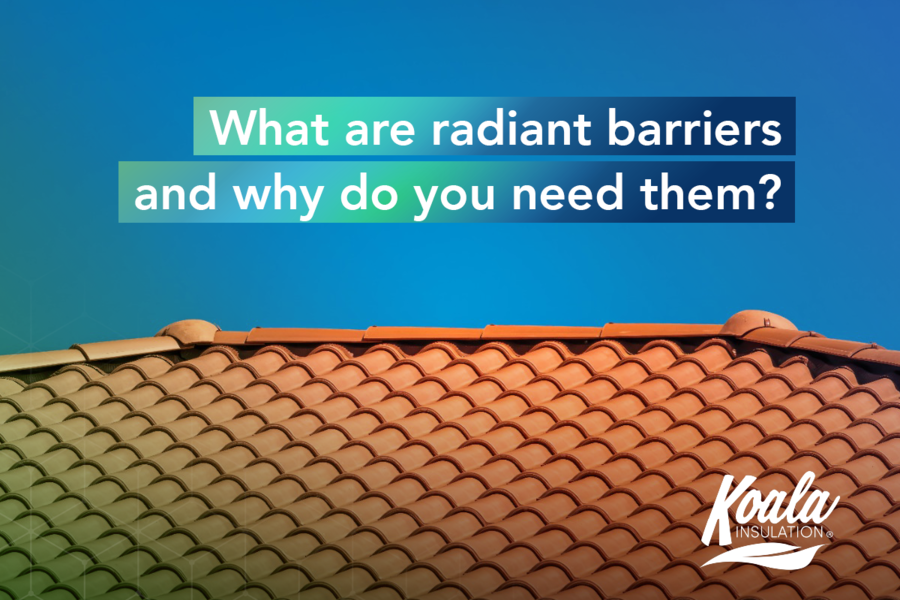
What are Radiant Barriers and why do you need them?

If you’ve been looking into ways to make your attic more energy-efficient, you may have come across radiant barrier technology. Radiant barriers are one of the best and most innovative ways to take control of the temperature in your home. Understanding what a radiant barrier is and why it works can help you save hundreds on your electricity bills.
What is a radiant barrier?
Radiant barriers are materials that are installed in buildings to reduce summer heat gain and winter heat loss - so overall to reduce building heating and cooling energy usage. A radiant barrier is anything that reflects heat back to the source. It keeps an object from becoming energized by UV rays and radiating its own heat. The barriers consist of a highly reflective material that reflects radiant heat rather than absorbing it. They don't, however, reduce heat conduction like thermal insulation materials.
How do Radiant Barriers work?
Heat travels from a warm area to a cool area by a combination of conduction, convection, and radiation. Radiant barriers block radiant heat energy instead of absorbing it like conventional mass insulations (fiberglass, cellulose). In addition, radiant barriers are unaffected by humidity and will continue to perform at a consistent level no matter how humid the seasonal climate.
When the radiant South Miami heat from the sun hits the attic roof, it heats up the shingles, plywood decking, trusses, walls, etc. Those items then continue to build up and radiate their own heat in all directions. While half of that heat may go back outside, the other half continues right on into the attic space. This heats up the insulation in the attic, the floor, the drywall that makes up your ceiling, and eventually, penetrates into the living space including all of the A/C ductwork that carries cool air throughout your home. Radiant barriers and reflective insulation systems work by reducing radiant heat gain and helping your HVAC systems not work overtime. Radiant barriers are more effective in hot climates than in cool climates, especially when cooling air ducts are located in the attic. Some studies show that radiant barriers can reduce cooling costs 5% to 10% when used in a warm, sunny climate. The reduced heat gain may even allow for a smaller air conditioning system.
Are radiant barriers important?
Radiant barriers are the first steps to block radiant heat coming in from the sun. Your attic floor insulation is the second step which blocks conductive heat flow to the rooms below. Radiant barrier products actually make your attic insulation work better, if you're looking to save hundreds on your energy bills then you should most definitely consider a combination of insulation and radiant barriers for your home. When a radiant barrier is placed on the attic floor, much of the heat radiated from the hot roof is reflected back toward the roof. This makes the top surface of the insulation cooler than it would have been without a radiant barrier and thus reduces the amount of heat that moves through the insulation into the rooms below the ceiling.
What are the characteristics of a radiant barrier
Radiant barriers consist of a highly reflective material, usually aluminum foil, which is applied to one or both sides of a number of substrate materials such as kraft paper, plastic films, cardboard, oriented strand board, and air infiltration barrier material. The surface is typically a very thin, mirror-like aluminum foil. The foil may be coated for resistance to the elements or for abrasion resistance and the radiant barrier can be one- or two-sided. One-sided radiant barrier may be attached to insulating materials, some products are fiber-reinforced to increase durability and ease of handling. Unlike conventional insulation, radiant barriers are not rated by their R-value as their performance depends on too many different variables. Radiant barriers can be used in residential, commercial, and industrial buildings. A properly functioning radiant barrier offers incredible value. They’re a low-cost solution that complements the benefits of other insulation throughout your home.
What should a radiant barrier installation cost? And who should install it?
A radiant barrier's effectiveness depends on proper installation, so it's best to use a certified installer. Finally, remember that a radiant barrier only works when it is clean and shiny, which preserves its reflectivity. If it gets dirty or dusty during construction or during operation, it stops working as a radiant barrier and works more like a typical surface. Costs for an attic radiant barrier will depend on several factors, including the following:
- is the radiant barrier installed by the homeowner or by a contractor?
- whether the radiant barrier is installed on the attic floor or on the rafters
- will the radiant barriers be installed in a new home (low cost) or in an existing home?
- necessary retrofit measures such as adding venting can increase the cost
- desired extra "features"; e.g. a radiant barrier with perforations and reinforcements may be more expensive than a "basic" radiant barrier
If you have been looking into installing radiant barriers do not hesitate and call us, we will not only properly install your radiant barriers but we will help you decide on where they would work best in your specific home. Contact us today at Koala Insulation of South Miami and take advantage of our free insulation evaluation.
Ready to book your free insulation evaluation?
We have 3 convienant ways for you to get in touch
We Provide Insulation Services to the Following South Miami Areas
Miami, Homestead
Counties Served
Miami-Dade County
Zip Code
33116, 33175, 33176, 33183, 33186, 33133, 33134, 33143, 33145, 33146, 33155, 33030, 33031, 33032, 33033, 33035, 33039, 33170, 33156, 33157, 33158, 33177, 33189, 33190
